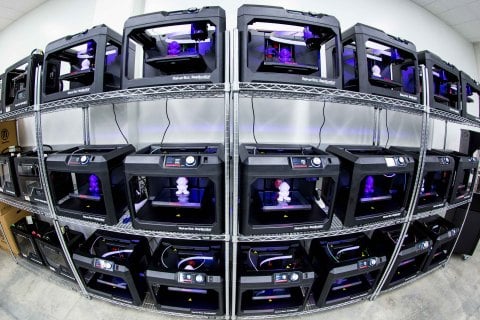
We noticed a peculiar economic scenario that arises from MakerBot’s Innovation Center.
If you don’t know already, MakerBot’s Innovation Center is a fascinating system for clustering MakerBot gear, targeted at institutions wishing to provide a high-capacity, reliable 3D print service. Clustering machines provides much more capacity due to the ability to print many items in parallel, while failures are easily handled when many other machines still function within an operating cluster.
There seems to be a cascade of savings scenarios. Consider the traditional case for industrial 3D printing: prototypes would normally be built using conventional CNC milling, which could be quite expensive. A prototype built in this way could cost tens of thousands of dollars, and many companies used and still use this approach. But by using an industrial 3D printer, one could reduce the cost of those prototype parts to mere thousands, saving a great deal of money. That’s how it’s worked for more than a decade of industrial 3D printing.
But MakerBot’s Innovation Center seems to put another layer on top of those existing 3D printer savings. What if that 3D printed part that cost thousands on an industrial 3D printer could cost only a few dollars?
Some have attempted to do this using personal 3D printing equipment, but this approach has been limited by operational concerns: expensive industrial machines typically provide significant more reliability, operator monitoring, logging and other features often required by larger businesses. These features most often are not found in personal 3D printers.
But then MakerBot created Innovation Center, which does implement most of these features by leveraging clusters of machines. This makes their equipment much more palatable for larger businesses – while still enabling a dramatic reduction in print costs over single industrial 3D printers.
Does this approach work? Apparently so, as MakerBot has made a number of Innovation Center sales to larger institutions, particularly universities.
What effects will this have on MakerBot and the rest of the 3D printing world? Stay tuned for another post on that very soon.

